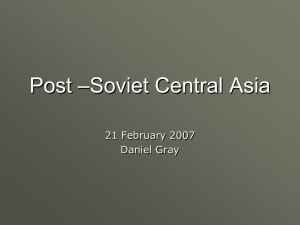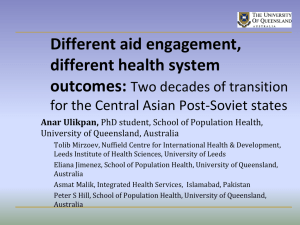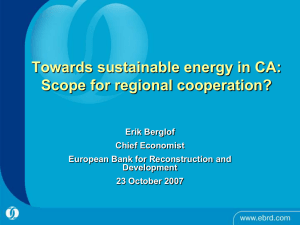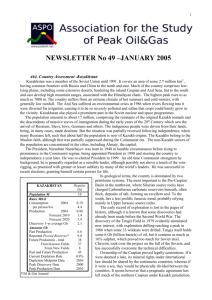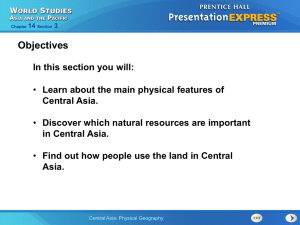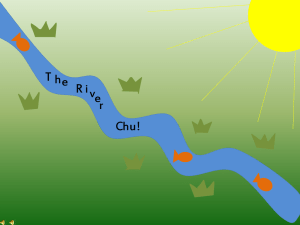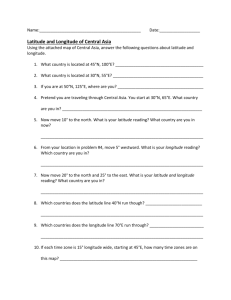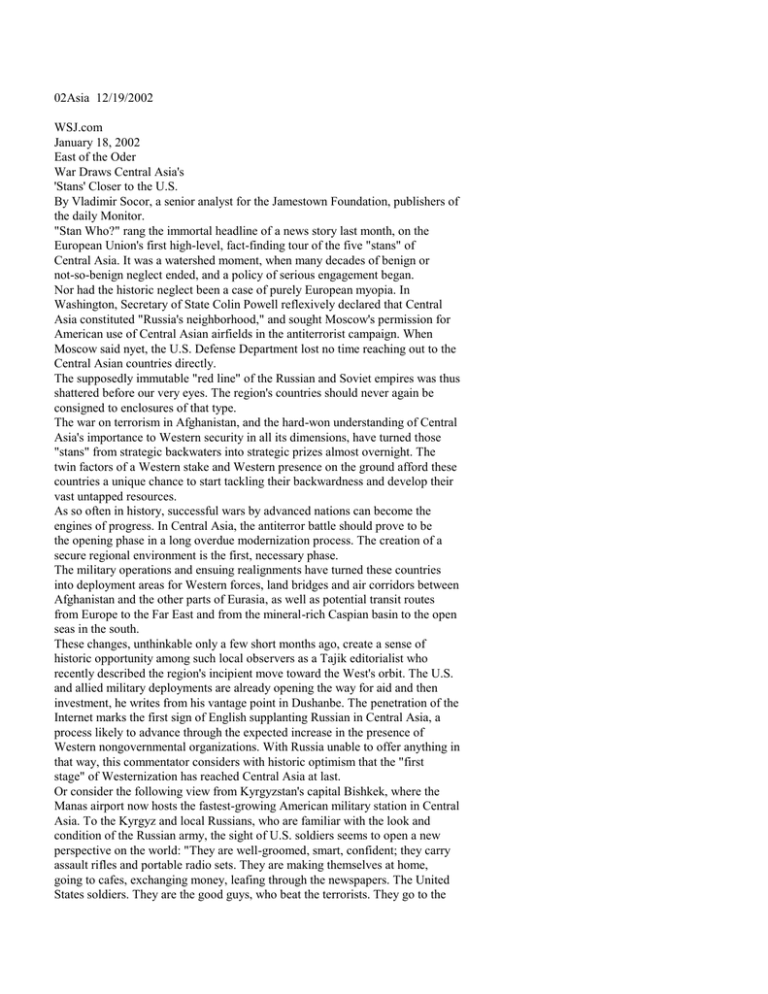
02Asia 12/19/2002
WSJ.com
January 18, 2002
East of the Oder
War Draws Central Asia's
'Stans' Closer to the U.S.
By Vladimir Socor, a senior analyst for the Jamestown Foundation, publishers of
the daily Monitor.
"Stan Who?" rang the immortal headline of a news story last month, on the
European Union's first high-level, fact-finding tour of the five "stans" of
Central Asia. It was a watershed moment, when many decades of benign or
not-so-benign neglect ended, and a policy of serious engagement began.
Nor had the historic neglect been a case of purely European myopia. In
Washington, Secretary of State Colin Powell reflexively declared that Central
Asia constituted "Russia's neighborhood," and sought Moscow's permission for
American use of Central Asian airfields in the antiterrorist campaign. When
Moscow said nyet, the U.S. Defense Department lost no time reaching out to the
Central Asian countries directly.
The supposedly immutable "red line" of the Russian and Soviet empires was thus
shattered before our very eyes. The region's countries should never again be
consigned to enclosures of that type.
The war on terrorism in Afghanistan, and the hard-won understanding of Central
Asia's importance to Western security in all its dimensions, have turned those
"stans" from strategic backwaters into strategic prizes almost overnight. The
twin factors of a Western stake and Western presence on the ground afford these
countries a unique chance to start tackling their backwardness and develop their
vast untapped resources.
As so often in history, successful wars by advanced nations can become the
engines of progress. In Central Asia, the antiterror battle should prove to be
the opening phase in a long overdue modernization process. The creation of a
secure regional environment is the first, necessary phase.
The military operations and ensuing realignments have turned these countries
into deployment areas for Western forces, land bridges and air corridors between
Afghanistan and the other parts of Eurasia, as well as potential transit routes
from Europe to the Far East and from the mineral-rich Caspian basin to the open
seas in the south.
These changes, unthinkable only a few short months ago, create a sense of
historic opportunity among such local observers as a Tajik editorialist who
recently described the region's incipient move toward the West's orbit. The U.S.
and allied military deployments are already opening the way for aid and then
investment, he writes from his vantage point in Dushanbe. The penetration of the
Internet marks the first sign of English supplanting Russian in Central Asia, a
process likely to advance through the expected increase in the presence of
Western nongovernmental organizations. With Russia unable to offer anything in
that way, this commentator considers with historic optimism that the "first
stage" of Westernization has reached Central Asia at last.
Or consider the following view from Kyrgyzstan's capital Bishkek, where the
Manas airport now hosts the fastest-growing American military station in Central
Asia. To the Kyrgyz and local Russians, who are familiar with the look and
condition of the Russian army, the sight of U.S. soldiers seems to open a new
perspective on the world: "They are well-groomed, smart, confident; they carry
assault rifles and portable radio sets. They are making themselves at home,
going to cafes, exchanging money, leafing through the newspapers. The United
States soldiers. They are the good guys, who beat the terrorists. They go to the
village to stock up on goods. Local people hope for dollar opportunities."
The economies of these countries -- with the partial exception of oil-wealthy
Kazakhstan -- are clearly unable to recover unaided from their Soviet and
post-Soviet distress. The prime minister of Kyrgyzstan has described the U.S.
military presence as equivalent to a "gold mine" for the country. In the wake of
Western soldiers, there follow aid packages and development loans. Such
commitments by the U.S., France, and Japan helped sway Tajikistan's president,
Imomali Rahmonov, into making his country's military airfields available to the
countries of the antiterrorist coalition.
The Uzbek and Kazak presidents had been the first in the region to offer their
countries' military airports for use by American forces. For reasons of
geography, Kazakstan's airfields are not directly relevant to military
operations in Afghanistan. As those operations are winding down, President
Nursultan Nazarbaev now proposes that U.S.-trained Kazak soldiers join the
International Security Assistance Force in Afghanistan.
Uzbekistan's Hanabad base proved invaluable during the intensive phases of
military operations in northern Afghanistan. At Hanabad as at Manas, the U.S.
forces seem to be preparing for an open-ended presence. Uzbek President Islam
Karimov has signed with the United States a far-reaching security agreement. All
five Central Asian countries had in recent years experienced the threat of
terrorism, with Uzbekistan the main target for the longest time. But they also
experienced Moscow's manipulation of terrorist threats and even covert
cooperation with such violent groups as the Islamic Movement of Uzbekistan.
With these tactics, the Kremlin had sought to foster insecurity, only to offer
its protection in the form of political, economic and military control. The
method has been described on this page ("Whose Terrorists Are These Anyway?1",
May 25, 2001). Ahmed Rashid, writing in the current issue of the New Yorker,
lists no fewer than four occasions in 1999-2000 when Russian troops escorted IMU
forces across borders, en route to and from guerrilla operations in Uzbekistan,
Kyrgyzstan, Tajikistan and northern Afghanistan.
Yet Moscow remained the main source of military "assistance and protection" as
long as the U.S. and the Europeans were not actively involved in the region. No
wonder that the region's leaders came to distrust and fear Moscow, and no wonder
they took their chance to escape from that relationship as soon as that chance
presented itself in the form of the American-led coalition.
The relationship now developing between the West and the "stans" is historically
unprecedented and faces some daunting obstacles. These include, on the Central
Asians' side, the stifling legacy of oriental despotism, the after-effects of
Russian colonialism and the social destruction inflicted by Soviet socialism. On
either side, it remains to be seen whether the reservoirs of good will are going
to outweigh those of mutual incomprehension between Western democracies and
Central Asian countries with an absolute lack of democratic traditions. Perhaps,
therefore, the worst source of danger to this relationship is haste, impatience
for immediate results, pressure for rapid rather than evolutionary changes.
These dangers exist on either side of this new relationship; but it is incumbent
on the more mature and more experienced side to set the realistic, feasible pace
of democratic progress.
-- From The Wall Street Journal Europe
URL for this Article:
http://interactive.wsj.com/archive/retrieve.cgi?id=SB1011305063721919040.djm
Hyperlinks in this Article:
(1) http://interactive.wsj.com/archive/retrieve.cgi?id=SB990734466357071699.djm
2
Copyright © 2002 Dow Jones & Company, Inc. All Rights Reserved.
Printing, distribution, and use of this material is governed by your
Subscription Agreement and copyright laws.
For information about subscribing, go to http://wsj.com
Economist.com
Counting the cost
Apr 8th 2002
From The Economist Global Agenda
The plight of many of the countries which used to belong to the former Soviet
Union is once again under the spotlight, with the World Bank president on an
eight-day visit to Central Asia. Seven countries in the Commonwealth of
Independent States are among the poorest in the world
FREEDOM has its price. For the seven poorest members of the Commonwealth of
Independent States (CIS), those countries which used to form the Soviet Union,
the transition to independent political and economic existence has been
unexpectedly prolonged and painful. The sorry state of these nations—in dollar
terms, now among the poorest in the world—was the focus of an international
meeting in London in February, part of a process aimed at helping the former
Soviet states grapple more effectively with their problems. Now James
Wolfensohn, president of the World Bank, is on an eight-day visit to Central
Asia to see for himself.
The scale of the difficulties that the seven countries face is daunting.
Armenia, Azerbaijan, Georgia, Kirgizstan, Moldova, Tajikistan and Uzbekistan
have endured a series of catastrophic economic, political and even military
shocks in the decade since the break-up of the Soviet Union. Some countries have
been torn apart by armed conflict and civil war. Real GDP in this group fell by
an average of almost 50% between 1990 and 1995. Poverty and inequality have
increased substantially. Indicators of living standards such as nutritional
status and life expectancy remain low and in some cases have worsened. In some
cases, governments have accumulated large amounts of foreign debt, usually with
little to show for it.
The principal international economic institutions are now working with the
biggest donor countries and the seven CIS countries themselves to grapple with
some of the problems they face, and to establish new forms of help for them in
return for clear commitments from the recipients. As part of this process, the
International Monetary Fund, the World Bank, the Asian Development Bank and the
European Bank for Reconstruction and Development jointly sponsored what was
described as a “brainstorming seminar”, hosted by the British government in
London on February 21st-22nd. Donor countries and the CIS-7 were represented at
the meeting which will be followed by a further, senior-level meeting in
Washington, DC, on April 20th. The aim is to agree on a specific action
programme, and a timetable, at the Washington meeting. Mr Wolfensohn's visit to
the region is focused very much on the sort of reforms needed to reduce poverty.
The international war on terrorism, and the overthrow of the Taliban regime in
Afghanistan, has certainly given added urgency to the need to help poor and
unstable countries, especially those in a strategically-sensitive part of the
world. Several of these seven countries have common borders with Afghanistan,
and their proximity to the conflict has done nothing to encourage investment and
3
trade flows to the region. Since September 11th, the West has become more
acutely aware of the need to try to restore political and economic stability to
countries rather than to let them become havens for the disillusioned and the
disgruntled.
Of these seven, the transition from socialism has been hardest for the five
countries who have few natural resources (Azerbaijan and Uzbekistan have oil
reserves). The loss of the huge oil-and-gas subsidies that they had enjoyed from
the Soviet Union, and the subsequent need to adjust to world prices, was a
massive blow to them, equivalent to up to 15% of GDP. These were anyway
countries that used energy inefficiently. But because of the way the Soviet
economy was organised, much of the industrial activity in all seven countries
was, once exposed to the outside world, hopelessly uncompetitive. The economic
authorities in these countries found themselves struggling to find outside
sources of money—which led them into heavy and ultimately unsustainable foreign
borrowing—while trying to cope with rampant inflation (hyperinflation in some
cases). Above all, they were having to create the institutions of modern
governance—right down to the basics of a functioning central bank, tax
administration and treasury—from scratch. This they managed with varying degrees
of success. Private and public corruption, though, remain big obstacles to
progress.
It’s not all gloom and doom. Most countries took important steps towards
becoming market economies at an early stage, perhaps before the full
implications of doing so became clear. Prices, and in most cases, exchange
rates, were liberalised reasonably quickly. Inflation was, again in most cases,
brought under control. The corresponding fall in output, however, was much more
severe than anticipated, partly because of the very large terms-of-trade shock,
partly because of persistent political instability and partly because the
adjustment needed for most transition economies was greater than most economists
realised before the collapse of the Soviet Union. Despite the fact that their
economies have grown since 1995, the sharp contractions in the first half of the
1990s has left a legacy of great poverty and inequality. It has also probably
contributed to the mixed progress on political and institutional reform.
Since 1999, in particular, these seven countries have benefited from strong
growth in Russia and the Ukraine; even before that, they were doing better than
most other CIS countries, but from a much weaker base. Since 1995, growth in the
CIS-7 has averaged 4% a year. And yet despite this, they remain desperately
poor. In dollar terms their nominal GDP per person in 2000 ranged from $158 in
Tajikistan to $652 in Azerbaijan. The comparable figure for Russia, itself still
struggling to make the transition to a market economy, is $1,720.
The international institutions involved have put forward a plan which would
involve all parties—the institutions, donor countries and the recipients
themselves—promising to co-operate to make further reforms feasible and
effective. Part of the aim would be to increase aid and investment and to make
such flows more predictable. International lending institutions would pledge
greater co-operation among themselves—not an insignificant challenge when so
many are involved—and would aim to beef up the quality of the policy advice they
provide. They might, in some cases anyway, offer more attractive lending terms.
So might bilateral donors, who would be expected to provide more grants instead
of loans, and perhaps debt relief as well.
But the international banks and the IMF make it clear that their primary aim is
to help these countries to help themselves. The extra help would generally be
triggered by reforms in the CIS-7: reform of economic and political
institutions; reform of corporate governance, including more effective investor
protection; and greater efforts to stamp out corruption. The idea would be to
create a more stable economic framework and, crucially, a better domestic
business environment which would help attract foreign investment. There would be
help in achieving what in some cases represents very sweeping changes, both from
4
the international financial institutions and from political co-operation at the
regional level. Such co-operation could try to tackle region-wide issues, such
as the water and energy problems in Central Asia that currently hamper economic
growth prospects. Regional partnerships might also help resolve international
political disputes which similarly blight the economic outlook.
The biggest challenge, though, is fundamentally for the political leadership in
the CIS-7. It is they who must take the initiative, and it is they who, with
help, must push through changes which will often be unpopular either with the
electorate as a whole, or with powerful vested interests. The task facing
international financial instititutions and western aid donors is to persuade
these leaders that making the unpopular changes is a challenge worth
undertaking.
Copyright © 2002 The Economist Newspaper and The Economist Group. All
rights reserved.
Spotlight on Central Asia Is Finding Repression, Too
April 11, 2002
Spotlight on Central Asia Is Finding Repression, Too
By EDMUND L. ANDREWS
ISHKEK, Kyrgyzstan, April 10 — The United States' newest strategic
partners, the impoverished former Soviet republics of Central Asia, are
undergoing a surge of repression and corruption just as they are
attracting new world attention.
Nursultan A. Nazarbayev, president of Kazakhstan, imprisoned two of his
leading political rivals two weeks ago and has ignored objections about it
from the United States and the European Union. Last week, Kazakhstan's
prime minister admitted that more than $1 billion had been transferred to
off-shore bank accounts in Mr. Nazarbayev's name.
In neighboring Kyrgyzstan, which is now hosting a new American air base
for attacks on Afghanistan, the government has shut down two opposition
newspapers. Last month, the police killed seven demonstrators protesting
the imprisonment of a member of Parliament.
Uzbekistan, Central Asia's most populous country and the host of another
military base used by the United States has one of the worst records in
the region for human rights. As it has attempted to clamp down on people
suspected of sympathizing with radical Islamic groups, experts say,
Uzbekistan has raised major barriers with neighboring countries,
disrupting the movement of both goods and people across state borders.
Tajikistan, the region's poorest country, remains a central corridor for
heroin smuggling.
The authoritarian turn in these Eurasian allies is problematic for
Washington, which is relying on their support for the military operation
in Afghanistan. The Bush administration has criticized the human rights
record of several of the governments but has been careful not to undermine
them.
All this provided a backdrop to gala meetings in Kazakhstan on Monday and
Tuesday of the World Economic Forum's Eurasian Summit, which attracted
hundreds of Western business executives and government officials.
At a packed cocktail party hosted by Mr. Nazarbayev on Monday night, top
government officials quietly insisted that the recent political arrests
were a mere legal problem and that the diverted money was a rainy-day fund
in case of abrupt shortfalls in government revenue.
Prime Minister Imangali Tasmagambetov insisted that $400 million from the
5
secret $1 billion fund had been drawn to cover government obligations in
1997, when the country was badly shaken by Russia's financial downturn.
At least in public, many executives at the conference seemed unconcerned.
"I don't get involved in those issues," said one. "It has no impact on
what we do at all."
Kazakhstan, a vast country that has emerged as one of the world's biggest
new sources of oil, is drawing billions of dollars of investment from
drilling and pipeline companies that include ChevronTexaco and Exxon
Mobil. For it and neighboring countries in the region, the twin allures of
tapping oil and helping in the American-led war against terrorism have
brought elevated geopolitical significance.
"Since Sept. 11, a lot of our shareholders discerned the importance of
this region, and we ourselves are going to take advantage of that to wield
a cohesive policy," said James D. Wolfensohn, president of the World Bank,
who is touring five Central Asian countries this week.
The World Bank, which loaned $3.5 billion to central Asian countries over
the past 10 years, plans to loan at least $1.5 billion over the next 10
years. The European Bank for Reconstruction and Development plans to
invest $300 million over the next several years. The United States, on its
own, is providing hundreds of millions of dollars in new assistance as
well.
Even as the Eurasian conference was under way, several countries were
cracking down harder than usual on political opponents.
Here in Kazakhstan, two founders of a new opposition party called
Democratic Choice for Kazakhstan remained incarcerated throughout the
conference.
One of the men, Mukhtar Ablyazov, is a former governor who is also a
founder of two opposition newspapers and an opposition television network
called TAN. The other, Galymzhan Zhakiyanov, is a former energy minister.
He took refuge for nearly a week in the French Embassy here and is now
under house arrest.
Meanwhile, the government has shut down Mr. Ablyazov's newspapers, and an
unidentified person blacked out TAN's broadcast in Almaty by shooting a
cable that fed signals to its transmission tower.
Government leaders say both men have been charged with crimes: Mr.
Ablyazov for soliciting prostitutes and Mr. Zhakiyanov for misusing his
office as energy minister.
"It is nothing more than a criminal proceeding," said Karim Massimov,
Kazakhstan's deputy prime minister. "It will be decided in court."
In Kyrgyzstan, police officers killed 7 people and wounded at least 17
others in mid-March at a protest rally in the village of Kerben. The
country's leaders said the police had fired only after the protesters
became violent. But last week, human rights groups revealed a police
videotape of the incident that they said showed the police blocked a
peaceful march and then fired on unarmed people.
"It was absolutely clear from the video that the protesters were unarmed,"
said Natalia Ablova, director of the Bureau on Human Rights and Rule of
Law, a group based here.
Some longtime observers believe, however, that Kyrgyzstan's president,
Askar Akeyev, has been one of the region's more courageous reformers. He
has ushered in a host of market-opening measures that reduced the power of
old monopolies and encouraged competition.
But one senior Western diplomat said that political repression in
Kyrgyzstan has deep roots. "They have been doing it for a long time," he
said. "It's not better. It's not worse. It is manifesting itself in a
different way."
Business executives and diplomats say that every country in Central Asia
has a serious problem with corruption. In Tajikistan, for example, drug
trafficking has become such an ingrained part of the economy that Western
companies and lending institutions like the World Bank have largely
stopped their activities there entirely.
6
The fear of infiltration by Muslim militants has added to the
difficulties, causing countries like Tajikistan and Uzbekistan to impose
ever tougher restrictions and higher barriers along their borders with
neighboring countries. The Uzbeks have put mines along some of their
border areas with Kyrgyzstan, which have killed many traders and
shepherds.
"The new map of Central Asia is being defined by a process that is often
antagonistic and tainted by strong-arm politics, economic pressures,
shadowy back-room deals, nationalist sentiments and an environment of
mutual mistrust," said the International Crisis Group, a nonprofit
organization that monitors tensions in the region.
It does not help that Uzbek leaders feel they are in constant rivalry with
Kazakhstan to be recognized as the leaders of Central Asia. Thus, while
almost everybody at the Eurasia meeting insisted on the need for "regional
cooperation," top Uzbek leaders did not attend.
Home | Back to International | Search | Help Back to Top
Copyright 2002 The New York Times Company | Privacy Information
Economist.com
Militant Islam
Stabler Stans
Mar 14th 2002
From The Economist print edition
Jihad: The Rise of Militant Islam in Central Asia
By Ahmed Rashid
Yale University Press; 272 pages; $24 and £16.95
Buy it at
Amazon.com
Amazon.co.uk
NO JOURNALIST or academic, and probably very few spooks, know Central Asia
better than Ahmed Rashid, the Pakistani writer whose earlier book,
“Taliban”,
became an instant bestseller after September 11th. Now he has followed it up
with a valuable survey of the spread of Islamic militancy beyond Afghanistan
into the five former Soviet republics of Central Asia. The book deserves to be
widely read, this time before catastrophe strikes rather than afterwards.
The republics of Kazakhstan, Kirgizstan, Turkmenistan, Tajikistan and Uzbekistan
are well off the beaten track, even for most policymakers. But here, since the
7
fall of the Soviet Union, radical Islam has taken root over the last decade with
extraordinary vigour. The rise to power of the Taliban in Afghanistan acted as
an accelerator, helping to turn what began as an avowedly non-violent protest
movement into something much more dangerous. It was in Kabul that the creation
of the most militant group, the Islamic Movement of Uzbekistan (IMU), was
announced. The IMU aims at the violent overthrow of the government of
Uzbekistan, the most populous and powerful of the republics, and has launched
repeated incursions into the territory of Uzbekistan and Kirgizstan from bases
in Afghanistan and Tajikistan.
EPA
By the book
Unfortunately but inevitably, given the pace at which history is unfolding in
the expanses of Central Asia, Mr Rashid's book is already somewhat out of date.
Publication deadlines meant that he was unable to take account of the overthrow
of the Taliban and with it the heavy losses inflicted on the IMU, including the
reported, though unconfirmed, death of its leader, Juma Namangani. That is a
pity, since the entire dynamics of the region have now changed. The IMU has
suffered blows from which it will find it very hard to recover, while the
various “Stans”—Uzbekistan in particular—find themselves in the
happy position
of receiving support from America, Russia and China, all of whom now see them as
being at the frontline in the battle to contain fundamentalism. The chances of
any of the regimes being overthrown have receded. They were never, in fact,
terribly great, since the IMU probably never amounted to more than a couple of
thousand fighters.
Still, as Mr Rashid explains very fully, there were powerful reasons why Islam
could flourish as it has done, and they have not changed. Islamism in Central
Asia has been first and foremost a response to repression and extreme poverty,
and there is no sign that any of the five regimes are becoming any less
repressive or significantly less poor. Rather the reverse: there is no longer
any outside pressure on the autocrats to mend their ways. Tens of thousands of
members of the Hizb-ut Tahrir, which, unlike the IMU, advocates only peaceful
means for the creation of an Islamic caliphate in Central Asia, languish in
prison, while corruption and mismanagement are ever-increasing. A future
explosion, whether religious or political, cannot be discounted. But at least
the Taliban are no longer there to prime it.
Jihad: The Rise of Militant Islam in Central Asia.
By Ahmed Rashid.
Yale University Press; 272 pages; $24 and £16.95
Copyright © 2002 The Economist Newspaper and The Economist Group. All
rights reserved.
Central Asian University Aims to Train Next Leaders
August 26, 2002
Central Asian University Aims to Train Next Leaders
By BARBARA CROSSETTE
8
n Central Asia, where authoritarian leaders thwart democracy and Islamic
militancy is a threat, a group of international scholars are creating a
regional university to bring secular education to people in some of the
remotest, most forbidding and poverty-stricken regions.
"We want to give them the opportunity to be modern and remain where their
forefathers have lived," said S. Frederick Starr, the chairman of the
Central Asia-Caucasus Institute at Johns Hopkins School of Advanced
International Studies in Washington and a member of the team devising the
new institution, the University of Central Asia.
The university will offer degree programs based on a liberal arts and
sciences curriculum, unlike the specialist programs of the Soviet era. The
programs are being created to serve a new elite in the hope that they will
provide leadership in the region. Fees will be charged.
But each of the three campuses will also offer continuing and vocational
education for ordinary civil servants, farmers and merchants.
Mr. Starr, who speaks several regional languages, is acting as rector of
the university-in-the-making until a local administration is in place.
The university was established by a treaty that has been ratified, so far,
by the Parliaments of Tajikistan, Kazakhstan and Kyrgyzstan. The main
campus at Khorog, in the Badakhshan region of the Pamir Mountains in
Tajikistan, is already beginning to function as a continuing and
vocational education center.
Within the next four years, it is expected to become a fully equipped
undergraduate and graduate university — "coeducational, private,
nonsectarian and with a local faculty," Mr. Starr said in an interview.
Two other campuses will be built, at Tekeli, Kazakhstan, and Naryn,
Kyrgyzstan. The first phase of operations in Kazakhstan — also continuing
education — is being directed by a woman, Dr. Raikhan Sissekenova, a
public health specialist.
The poverty in those regions has deepened in the past 20 years, he said,
and people there have enough communication with the outside world to know
that they are losing out. "Everywhere, that creates tremendous volatility
and calls forth the deepest frustrations," he said.
The university is expected to cost about $200 million to build. The Aga
Khan Foundation pledged $15 million and has helped with start-up services
through its development network. Governments in several countries —
including Canada, Germany, Japan and Switzerland — as well as corporations
and other foundations are expected to contribute.
The Aga Khan, leader of moderate Ismaili Muslims, who are a majority in
the Khorog region, is the university's first chancellor.
Students will study English and computers before beginning course work,
and undergraduate degree courses will be taught in English, the language
that people in the region believe will best connect them to the outside
world. "We want enlightened and principled generalists who can provide a
moderate kind of leadership for the entire region," Mr. Starr said. Adult
education programs are intended to retrain civil service employees and
assist would-be entrepreneurs.
Payam Foroughi, an international consultant who worked in development
projects for three years in rural Tajikistan, questioned whether an
emphasis on English was wise. Mr. Foroughi said that Russian was already a
common language in the region and that local languages, including the form
of Tajik spoken in the Pamir Mountains around the main campus, needed to
be preserved and strengthened.
But Mr. Foroughi, who wrote the chapter on Tajikistan for a recent Freedom
House report on the uncertain state of democracy in Central Asia and other
post-Communist societies, agreed that an early emphasis on practical
skills was important.
"Tajik youth need education applicable to their lives," he said. "They
should not lose touch with the land, because many families are in
agriculture." Poor young people are too easily seduced by Islamic
9
militancy, he added.
Mr. Starr said that continuing education programs would always be taught
in regional dialects and that languages and courses would respond to local
needs.
When a researcher recently toured the Badakhshan region, on the border
with Afghanistan, to ask what people wanted to learn, women were among the
first to answer, Mr. Starr said. They wanted courses in women's legal
rights.
Copyright 2002 The New York Times Company | Permissions | Privacy Policy
WSJ.com - Central Asia Resists Pressure To Improve Human Rights
November 11, 2002
Central Asia Resists Pressure
To Improve Human Rights
By STEVE LEVINE
Staff Reporter of THE WALL STREET JOURNAL
ALMATY, Kazakhstan -- Several recent steps taken by Central Asian
republics suggest an increasing boldness against Western pressure by the
region's autocratic leaders, most of whom are key U.S. allies in its war
against terrorism, Western officials say.
Following the Sept. 11, 2001, terrorist attacks, the U.S. began using
Central Asia as a jumping-off point for its war to dislodge the Taliban in
neighboring Afghanistan. The U.S. established military bases in three of
the countries, Uzbekistan, Kyrgyzstan and Tajikistan, and obtained Air
Force landing rights in Kazakhstan. U.S. aid to the region more than
doubled.
In recent months, however, the U.S. and Europe have been increasingly
outspoken about the region's poor human-rights record, and in response,
the region's leaders have begun to publicly resist those pressures.
The Kazakh government says it officially charged a well-known opposition
journalist with raping a 14-year-old girl, an accusation Western officials
suggest may be politically motivated. The journalist, 49-year-old Sergei
Duvanov, had been planning a trip to the U.S. for speaking engagements on
Kazakhstan's human-rights record. He says the charges against him are
fabricated.
It is the third time Mr. Duvanov has accused the government of harassment
since he wrote a story earlier this year for an Internet site about Swiss
bank accounts allegedly belonging to President Nursultan Nazarbayev. The
accounts are part of separate money-laundering investigations by the U.S.
and Switzerland. In July, the Kazkah government charged Mr. Duvanov with
criminal libel for the story, and in August -- two weeks before he was to
attend a human-rights conference in Warsaw -- he was beaten and a cross
carved into his chest by unidentified men.
In a statement last week, the Organization for Security and Cooperation in
Europe said, "The pattern of incidents involving Mr. Duvanov, their
coincidence with his planned trips abroad to discuss publicly the
situation in Kazakhstan, and the disputed circumstances of the latest case
trigger concerns that these incidents may be politically motivated."
The U.S. and Europe are increasingly critical of President Nazarbayev,
particularly regarding a series of attacks on journalists. Mr. Duvanov's
beating was the eighth unexplained assault on a local reporter in the
country this year. The government has denied any role in the attacks, and
last week Mr. Nazarbayev admonished diplomats in a yearly meeting that he
10
"categorically rejects recommendations and advice aimed at unnaturally
speeding up democratic processes."
Mr. Nazarbayev's neighbors also appear increasingly brash, some analysts
say. In Kyrgyzstan, President Askar Akayev has faced a drawn-out test of
wills with his political opposition since police shot dead six
demonstrators last March. More recently, Mr. Akayev said it is time for
deeper democratic changes, yet critics complain that a Kyrgyz judge
recently overturned an election victory by an opposition figure, saying
his papers weren't in order, and gave the triumph to a challenger who
received just 19% of the vote.
Uzbekistan President Islam Karimov recently used a news conference with
United Nations Secretary-General Kofi Annan to assail critics of his
human-rights record. And in Turkmenistan, the European Bank for
Reconstruction and Development has blocked new loans for public projects
because of President Saparmurat Niyazov's poor record on political and
economic change.
"The key question is whether Washington's new relationship with these
countries has increased its leverage with them. The tenor of the leaders
in the region seems to indicate it hasn't," said Anthony Richter, director
of the Central Eurasia Project at the New York-based Open Society
Institute.
Write to Steve LeVine at steve.levine@wsj.com1
URL for this article:
http://online.wsj.com/article/0,,SB103697136414049828.djm,00.html
Hyperlinks in this Article:
(1) mailto:steve.levine@wsj.com
Updated November 11, 2002
Copyright 2002 Dow Jones & Company, Inc. All Rights Reserved
Printing, distribution, and use of this material is governed by your
Subscription agreement and Copyright laws.
For information about subscribing go to http://www.wsj.com
Grand Soviet Scheme for Water in Central Asia Is Foundering
December 9, 2002
Grand Soviet Scheme for Water in Central Asia Is Foundering
By MICHAEL WINES
UKUS, Uzbekistan — Forty years ago, when Uzbekistan was part of the Soviet
Union, the Kremlin ordained a colossal task: to turn this heat-puckered
land and four of its neighbors, a swath of desert and scrub as big as
Western Europe, into an irrigated cotton plantation.
Improbably, it succeeded.
From the mountainous Chinese border to the Caspian Sea, the Soviet Union
remade the two grand rivers of Central Asia, building 20,000 miles of
canals, 45 dams and more than 80 reservoirs. The government turned sand
and dust into one of the world's great cotton-growing regions.
But the Soviet Union is long dead. And here in western Uzbekistan and in
areas of its four neighbors, one of socialism's most grandiose schemes is
11
being sundered by capitalism, nationalism and a legacy of waste.
Without a bigger supply of water — or better use of it — an economic and
social crisis seems to be awaiting the region of 58 million people,
already racked by Islamic insurgencies and tamed by oppressive rule.
On a dusty plain outside this regional capital, one farmer, Yerken
Kharpov, unshaven and lean in blue nylon track pants, looked out at the 80
acres of state-owned farmland that he tends, and tallied the misery. In
2000, his entire crop died for lack of water. In 2001, again lacking
water, he grew but 10 acres of cotton. This spring, he tried again, with
15 acres of cotton and sunflowers.
Mr. Kharpov could give up, as he did three years ago, when he was a
28-year-old millworker, but without water, it is much harder to start
fresh. "There are no other jobs," he said. "Where would I go?"
Mr. Kharpov's question is Central Asia's. "We talk about the developing
world and the developed world," said Sarah O'Hara, a geographer at the
University of Nottingham, England, who has studied the water problems
here. "This is the deteriorating world."
The five nations at work here — Uzbekistan along with its arid neighbors,
Turkmenistan and Kazakhstan, and two mountainous ones, Tajikistan and
Kyrgyzstan — have drunk dry the natural flow of two great rivers, the Amu
and the Syr.
Not Enough to Go Around
The craving for water has turned the Aral Sea, once the world's
sixth-largest inland ocean, into a shrunken, dust-shrouded necklace of
lifeless brine lakes.
Still, the nations are thirsty. Their demand for water already exceeds the
entire annual flow of the two rivers by 25 percent. Adding to the
pressure, Afghanistan, whose right to river water was ignored during
Taliban rule, is poised to reclaim a share of the bigger river, the Amu.
The five neighbors have swelling populations — growing 15 percent a
decade, with a third of the residents 13 or younger. That presents their
governments with the challenge of creating more jobs and growing more
food, even as the water supply is divided ever more thinly.
They also are not keeping up the waterworks, causing more waste. In Soviet
times, the Kremlin spent at least $60 an acre every year to keep the water
systems in repair. Uzbekistan currently spends less than $25 an acre;
Tajikistan, reeling from civil war, spends $4.
One result is an irrigation network beset by staggering waste. Now in
disrepair, some parts waste more water than they deliver.
The Karakum Canal, an 837-mile man-made river in the Turkmenistan desert,
appears from the air as a thin line fringed by a miles-wide band of weeds.
The government admits that 28 percent of its water vanishes into the
sands. Scientists put the figure closer to 60 percent.
The region grew used to free water, in profligate supply. One example is
in the tiny village of Dzhalagash, along Kazakhstan's shadeless southern
border not far from the Syr's banks. Here the rainfall averages just 5.9
inches a year, yet the preferred crop is rice.
Zhakhslyk Kabyrov, who runs a former Soviet collective farm, hired Korean
advisers this year to help cut water consumption in his 250-acre rice
plot. Still, he reckons he will use a stunning 740 million gallons, enough
to fill 1,300 Olympic swimming pools, to flood paddies with ankle-deep
water to produce the rice.
He can consume so much because rice is a profitable staple of local diets,
and water, at about 65 cents per swimming pool, is ridiculously cheap.
Arid Kazakhstan grows an astounding 160,000 acres of rice — 250 square
miles of nothing but flooded paddies.
Uzbeks grow almost as much.
An obvious solution to such excess is to raise the price of water. But
that could wipe out an entire class of small farmers who comprise a future
capitalist class, while enriching the already wealthy. Moreover, controls
over water use are so loose, thanks in part to ramshackle equipment, that
12
fee dodging would probably be rampant. "If you were trying to save water,
you wouldn't grow rice," said Philip Micklin, a retired University of
Michigan geographer and a specialist on Central Asian water. "But look,
it's a management problem. Everyone makes choices. And sometimes it's not
even choices, it's who grabs the most."
A Regional Trade-Off
That is not how things were supposed to work. Instead, the Kremlin
conceived an elegant trade-off, linking the mountains rich in wild rivers
and glaciers with the arid plains, rich in gas, coal and oil.
And so, in the winter, the plains would send fuel to the mountains; in
return, the mountains would hoard river water, then send it downstream for
crops in the spring and summer.
The desert blossomed — and the Aral Sea became starved for water. A
fishing industry that had employed 40,000 workers and supplied one-sixth
of the Soviet catch also evaporated. So did a trapping industry that had
netted a half million muskrat pelts a year from the lush Syr and Amu
deltas.
Even so, central planners judged that the trade-off was a success, with
its bounty from 10 million new acres of crops.
"It was part of the five-year plans, approved by the council of ministers
and the Politburo," said Aleksandr Asarin, an expert at the Russian State
Hydroproject Institute who angered his bosses by predicting, in 1964, that
the sea was headed for catastrophe. "Nobody on a lower level would dare to
say a word contradicting those plans," he said, "even if it was the fate
of the Aral Sea."
If one bought the notion that a sea as big as Lake Michigan was
dispensable, then the trade-off worked — for a while. Cotton boomed, but
over time overwatering and leaks left farmland too salty to support crops,
and the river water, used and reused on its way downstream, became ever
saltier and more laced with pesticides.
What ultimately caused trouble was the potent brew of independence, which
collapsed the central control and socialist economics that underpinned the
tradeoffs for so long.
One colossal hydroelectric power station, the Toktogul, in Kyrgyzstan,
generated 10 billion kilowatt-hours of energy last year — enough to light
the Seattle area.
Yet in the winter, and the winter before, Toktogul's mighty turbines ran
at idling speed, and rolling blackouts swept across Kyrgyzstan.
Toktogul's operators were doing what they had done for decades: hoarding
water for summertime farm needs in Uzbekistan and Kazakhstan, rather than
generating power for Kyrgyz homes. The explanation is simple: they realize
that failure to open their sluices in the summer would cause their
neighbors economic chaos — and perhaps bring an army to their doorstep.
To forestall just such crises, the five nations signed an accord in the
early 1990's which essentially froze in place the water-distribution
scheme of Soviet times.
For the Kyrgyz, however, the trade-off of free summer water for free
winter fuel has been shattered. The plains states no longer return free
fuel in the winter. They sell it at market prices, or trade it for a
summer allotment of irrigation water based on a complex formula.
That leaves the Kyrgyz grumbling. In rainy years, when the plains states
irrigate less, they are obliged to return less fuel in the winter, meaning
that Kyrgyz citizens shiver. And in dry years, when the Kyrgyz are able to
send less irrigation water downstream, the plains states also return less
fuel in the winter. Again, Kyrgyz citizens shiver.
They also boil with resentment. "We're losing more than $90 million a
year, just from power losses," said Dyushen Mamatkanov, director of the
Institute of Water Problems in Bishkek, the capital of Kyrgyzstan.
"Toktogul is the property of Kyrgyzstan. We should have the maximum
economic effect from it."
Kyrgyzstan's Parliament agrees. Tired of enduring blackouts so Kazakh
13
farmers could flood rice paddies, the legislators voted two years ago to
authorize the government to charge outsiders for Kyrgyz water.
Kyrgyzstan's government has yet to bill its neighbors. But it has pressed
them to start picking up some of the cost of running hydroelectric dams
and maintaining reservoirs that exist largely to serve farmers on foreign
plains hundreds of miles away.
Tackling such troubles demands money — an estimated $40 billion for
serious repairs to the five-nation waterworks — and what is more,
agreement among five countries with very different notions of how the
rivers' bounty should be divided up.
For the moment, both are nearly as scarce as water itself.
Disputes rooted in disagreements over water rights in places like the
Fergana Valley, a cotton-growing center, actually erupted into clashes
that killed hundreds in the 1990's.
But regional resentments and jealousies abound. Despite a pledge to curb
the development of new irrigated farmland, Turkmenistan has proclaimed
plans to irrigate 1.2 million new acres — and to create a "Lake of the
Golden Turkmen," equal to the annual flow of both the Syr and the Amu, to
water them.
Kazakhstan is upset because the Syr is rife with salts and fertilizers by
the time it has been channeled through the cotton fields of the Fergana
Valley in Uzbekistan and dispatched downstream.
Uzbekistan was outraged in the mid-1990's because Kyrgyzstan, home to the
Syr's headwaters, was sending too much water south in the winter, too
little in the summer.
The Kyrgyz bridle at what they consider a near giveaway of river water
flowing from their mountains to the fields of Uzbeks and Kazakhs. And tiny
Tajikistan has submitted a proposal to increase its consumption of river
water over the next two decades by an amount roughly equal to 10 percent
of the two rivers' combined flow.
In the charged atmosphere, water has yet to become a weapon. But it can
easily become a blunt-edged bargaining tool.
Wielding Water as a Tool
Kyrgyzstan and Uzbekistan, for example, have a longstanding and often
mangled accord to swap water for natural gas. In December 2000, the flow
of Uzbek gas to Kyrgyzstan abruptly dwindled. Some say that Kyrgyzstan was
in arrears, or that Uzbek gas pipes had frozen or, others suspect, because
it was election eve, Uzbekistan was running short of heat in its capital,
Tashkent.
Whatever the reason, Kyrgyzstan warned that if gas flows did not resume,
it would open its reservoir sluices, flooding rich farmland downstream.
Uzbekistan got the message. Gas deliveries resumed.
Officials in Central Asia's labyrinthine water bureaucracy tend to argue
that such tiffs are the exception. Leaders of the five ex-Soviet nations
are united in their public commitment to divide the water equitably.
Mr. Asarin, the hydrologist who first predicted the Aral's demise, has
given up hope. The historic and economic pressures — to supply jobs and
food; to make money from cotton exports; to trump one's regional rivals —
are just too great.
None of Central Asia's water bureaucrats is savvier than Viktor Dukhovny,
whose Interstate Commission on Water Coordination in Tashkent monitors the
water uses of the five nations. Armed with a bank of computers, Mr.
Dukhovny's analysts can spit out plans by the dozens, factoring in endless
variables.
He is a rare optimist. "We have enough water for the survival of all five
states, even plus Afghanistan, if we will work together," he said. Then he
paused. "Of course, not forever," he added. "Only up to 2025."
Copyright The New York Times Company | Permissions | Privacy Policy
14

